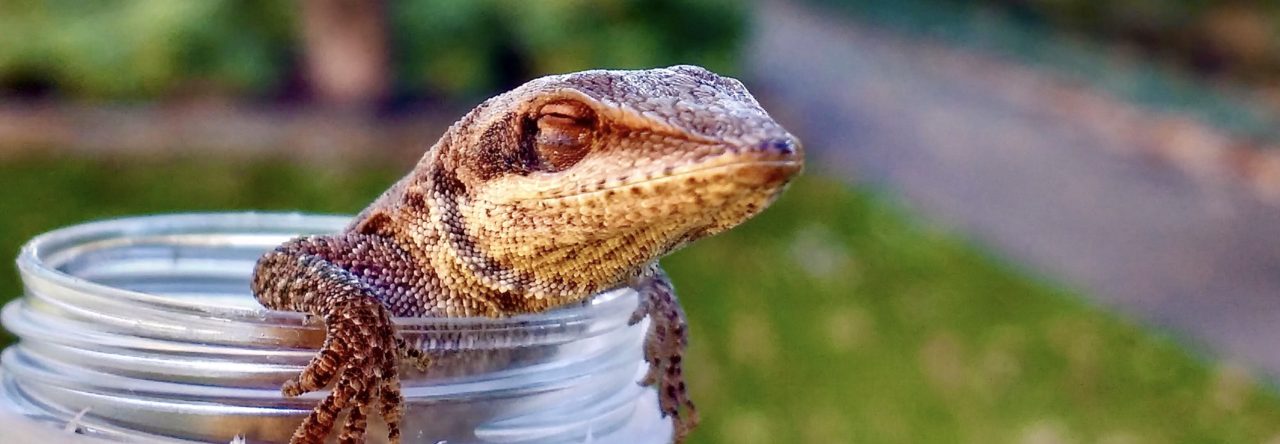A while back, we discussed whether bats eat anoles. It was recently brought to AA’s attention that anolivory by the common big-eared bat has been graphically documented in a 2011 PLoS One paper by Santana et al. Using videos taken at feeding roosts on Barro Colorado Island, the researchers documented three incidents of anoles being consumed, one of which is exhibited above (the anole looks like A. limifrons, a common species on BCI. Agree?).
As reported recently, these bats have become adept at scanning leaves for stationary prey, a major advance in bat foraging. One of the paper’s authors, Inga Geipel, confirmed that the lizards were caught during the night. As a result, apparently no sleeping anole is safe! The authors describe this foraging thusly: “M. microtis hunts on the wing, checking leaf by leaf in the forest while hovering up and down the understory vegetation.”
As for how they eat the anole, here’s the author’s description. Gruesome warning!!! Not for faint of heart:
Bats generally ate arthropods by repeatedly biting and crushing the prey’s head, or cephalothorax in the case of spiders, and then biting and discarding the wings, antennae and/or legs. Bats mostly used their premolar and molar teeth for the latter task, biting with one or both sides of the jaw. Once the prey’s head had been consumed and appendages had been discarded, bats consumed the thorax and abdomen biting with their molars and premolars and rotating the prey from one side of the jaw to the other.…Bats ate lizards in a similar fashion as they did arthropods, except that legs were also eaten along with the whole body. Bats started eating the lizard at the head (figure above), where they applied multiple molar bites. They continued to consume the lizard by chewing it with the molars using one side of the jaw, a behavior that continued throughout the consumption of the whole of the lizard. Apparently, lizards were eaten completely; the tail was not dropped.
- Evolution in Real Time on Lizard Island - March 23, 2025
- Spider Snags Adult Anolis osa - March 22, 2025
- An Homage to the Green Anoles of New Orleans - March 21, 2025



Frank Indiviglio
Hello,
In case this has not been mentioned in earlier articles…the False Vampire Bat, Vampyrum spectrum, specializes in catching vertebrates, likely takes anoles. This article describes a roosting site I encountered while on field research in Costa Rica http://blogs.thatpetplace.com/thatbirdblog/2009/03/11/drama-in-central-american-rainforests-the-half-moon-orange-fronted-or-petz%E2%80%99s-conure-aratinga-canicularis-and-the-false-vampire-bat-vampyrum-spectrum/#.UkImTD-cWpF
Here is another mentioning V. spectrum: http://blogs.thatpetplace.com/thatbirdblog/2008/04/25/parrots-and-the-perils-of-tropical-nights/#.UkInmj-cWpE.
Several Latin American bats hunt frogs, and there is a large Australian species that parallels the False Vampire in hunting style, prey selection.
I’m recently retired from the Bronx Zoo…mainly a herpetologist; I post herp articles here :
http://blogs.thatpetplace.com/thatreptileblog/2013/05/31/green-anole-intelligence-researchers-shocked-by-lizard-brainpower/.
Best regards, Frank
James (Skip) Lazell
I bet those bats are NOT “M. microtis.” Skip
Don Lyman
Good stuff, Jonathan. I remember hypothesizing at La Selva that bats might glean sleeping anoles and other prey from leaf tips.
This begs the question that if leaf tip sleeping behavior evolved in anoles under the selective pressure of predation by nocturnal snakes like Imantodes, and bats hunt sleeping anoles on leaf tips and other exposed sleeping perches, will this lead to the evolution of some new sleeping behavior? An interesting study, if it hasn’t already been done, might be to look at sleeping behavior within anoles species that are predated by bats, and see if there’s a range of sleeping behaviors, and which one(s) might yield the lowest predation rates.
With regard to Vampyrum, it is a fascinating and formidable predator, but with a wingspan of a meter, I’m guessing anoles would be too small a prey item for Vampyrum to actively forage for.